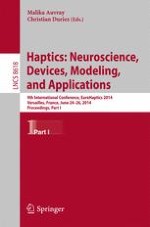The two-volume set LNCS 8618 and 8619 constitutes the refereed proceedings of the 9th International Conference EuroHaptics 2014, held in Versailles, France, in June 2014.
The 118 papers (36 oral presentations and 82 poster presentations) presented were carefully reviewed and selected from 183 submissions. Furthermore, 27 demos were exhibited, each of them resulting in a short paper included in the volumes. These proceedings reflect the multidisciplinary nature of EuroHaptics and cover topics such as human-computer interaction, human-robot interactions, neuroscience, perception and psychophysics, biomechanics and motor control, modelling and simulation; and a broad range of applications in medicine, rehabilitation, art, and design.
